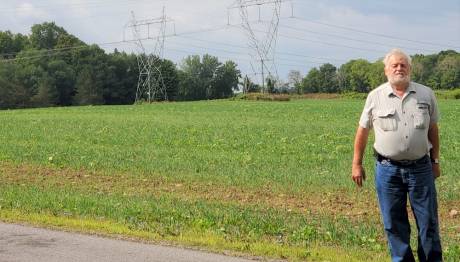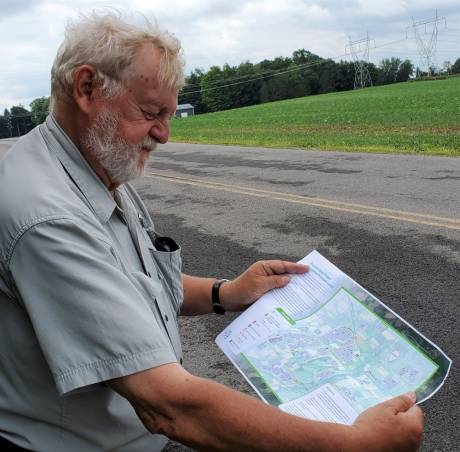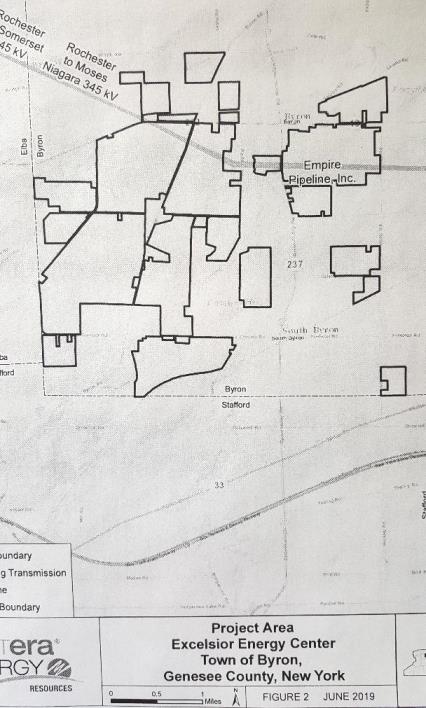In the 18 months since the announcement of a large scale, 280-megawatt Excelsior Solar Project in the Town of Byron, the principals involved have engaged in considerable posturing and legal maneuvering.
Excelsior Energy Center, a subsidiary of NextEra Energy Resources LLC, based in Vero Beach, Fla., is proposing to construct 1,600- to 1,700-acre solar electric generating facility under Article 10 of the New York State Public Service Law.
The Article 10 law directs the NYS Board on Electric Generation Siting and the Environment in regard to construction and operation of solar project larger than 25 megawatts.
Four steps are part of the Article 10 process:
- Public involvement program (informational meetings and open houses);
- Preliminary scoping statement (details of the project);
- Formal application to the siting board;
- Siting board decision (to issue or deny the certificate).
About a year ago, the Byron Town Board hired an attorney to navigate the process.
Byron Town Supervisor Peter Yasses on Sunday said the board is taking a “neutral approach” as it updates its solar ordinance prior to Excelsior Energy’s submission of its final application to the state.
“We’re trying to get our zoning laws in place so that it won’t impact the people so much,” Yasses said.
The Byron Town Board’s next scheduled meeting is Sept. 26.
NextEra Closes in on Application Filing
Keddy Chandran, project manager for NextEra Energy Resources, today said his company is finalizing its formal application and expects to submit it by the end of September.
“We’re sort of nearing the end of that process after having incorporated the thoughts and input from various folks in the Town of Byron, residents, leadership and the planning board,” he said.
Chandran noted that NextEra recently distributed an informational mailer to residents that reveals “the status of the project, the conceptual map of the project layout and answers some general, frequently asked questions that we come across.”
Meanwhile, an opposition group of about 140 members known as Byron Association Against Solar secured legal counsel in an effort to, according to its website, “protest the large solar and wind projects that turn our valuable farmland into solar or wind projects that support New York City.”
Yasses said the proposed project has divided the community.
“It’s like the politics we’re seeing (at the national level) right now,” Yasses said. “Some people are for it and some people are against it. Some people are neutral. The people who are against it are strongly against it, and the people who are for it are strongly for it.”
The supervisor said he believes the system eventually will become a reality.
Yasses: There’s No Stopping It
“This is (Gov.) Andrew Cuomo’s pet project and we were told by the experts, our attorneys, that there is no stopping it,” he said. “It’s always good to have an opposition group, but it’s coming.”
Just last week, the siting board responded to a letter from BAAS attorneys objecting to Excelsior Energy’s desire to “forego the two open houses prior to filing its application, which are part of the company’s Public Involvement Plan.”
BAAS took the stance that Excelsior Energy should hold off on filing the formal application until after in-person open houses are conducted.
Per the letter, BAAS was “concerned that Excelsior is using COVID-19 as an excuse to deprive the public of the opportunity to learn about the project in person.”
“This action also serves to deprive Excelsior of the opportunity to understand all local concerns … which should play a prominent role in Excelsior’s proposals for studies necessary to quantify the environmental and economic impacts of the Project,” attorneys wrote.
The siting board ruled that the “public information sessions be held, but for protection of the public and participants that the sessions be conducted online” and that ample notice be given of the dates and times of the virtual sessions.
BAAS Wants an In-Person Meeting
Eric Zuber, a Byron Town council member and BAAS spokesperson, said the town board wasn’t informed about Excelsior Energy’s intentions until a couple hours before its Aug. 12th meeting.
“They put that notice out there at the 12th hour. They want to have a meeting by video; we really would like to have it an outside public place – at the rec hall or in the parking lot,” he said.
Acting on the siting board’s ruling, Chandran advised that two virtual open houses will take place on Aug. 31, with times to be announced. He and other members of the NextEra team will be on the available via the web platform.
Chandran said that although the solar project will consist of 1,600 to 1,700 acres, only about half of that area will be covered by solar panels.
“There’s road spacing in between (so) the actual impact is far less than that,” he said. “We have been working with the community tremendously over the past year, taking some of the concerns of the locality into account.”
Specifically, Chandran said major tree stands will not be disrupted – “keeping the rural character and landscape the same,” he noted – and that "some of those tree stands will be connected with game trails to allow free movement of wildlife between clusters of trees.” He also said that space will remain for snowmobile trails.
“We think that it’s a great layout for everybody,” he offered.
Zuber: The Science Points to ‘Harm’
Beyond that, Zuber, owner of a large dairy farm, said the project will “take away the best land in this town.”
“I see all the railroad cars filled with garbage being shipped from New York City through our area, to be dumped to the east, and now they want to take our land,” he said. “They’re treating us worse than they treated the (American) Indians.”
Zuber, said that “the science” shows that the project will do more harm than good.
“The governor is for renewable, but the sad thing is if you really look at the science, and get really in depth, this project is actually bad for climate change. It will make more carbon than what it will prevent,” he said.
“People don’t realize, the corn crop in America produces more oxygen than what the Amazon does. Taking the good land out of production, and then they want to put these solar panels on, they’re going to have to burn 20 percent of the electricity to boost the voltage high enough to push it down an antique line that was put in in 1956. Scientifically, the whole thing is a bad project.”
Zuber said BAAS supports the smaller solar farms that are cropping up in the area – those that supply energy to the local grid – but “it’s these big monstrous projects that want to take the very best ground and pump electricity 300 to 500 miles, it’s just ridiculous.”
He compared it to transporting water through a hose.
“The best way to describe it is that moving electricity is the same as moving water. If you run a three-quarter inch garden hose from here to New York City and try to pump water to New York City, there’s only one way that you can pump it through the garden hose and that’s by taking it to a tremendous amount of pressure,” he reasoned. “And that’s what voltage is. To push that electricity with that voltage that far, it’s absurd.”
‘Constructive, Respectful Conversation’
Chandran, when asked about the challenges dealing with those who oppose the project, said, “I wouldn’t say that they’re challenges.”
“We’re always engaging the community regardless of whether there is opposition or not. We have heard their concerns, just as we have listened to everybody’s concerns. So, I wouldn’t call it difficult. It’s just natural and we want to continue to have constructive, respectful conversation with them,” he said.
Zuber said BAAS is seeking professionals to conduct an agriculture impact study – the effects of taking “the best ground out of production.”
“Excelsior doesn’t want to look at agriculture at all. This thing is a job killer. For every man working on a dairy farm, there’s nine jobs down the line. We’re not going to milk cows in this town anymore; it’s going to cost 400 to 500 jobs,” he said.
Chandran disagreed with Zuber’s assessment, stating that the project will support around 70 farmworkers on the five or six farms that have entered into land leasing contracts with NextEra.
“In helping to diversify their income streams, we’re helping to insure their operations can continue into the future, and that supports their jobs. It’s a really good thing for them,” he said. “Also, this project will be creating a tremendous amount of jobs in the area, and generating revenue for the local economy. I don’t know where he is getting that information, (and) I’m not going to Mr. Zuber’s math on that.”
No Begrudging the Farmers
Zuber, however, said he doesn’t “begrudge” the farmers who have signed on.
“They’ve offered them a ton of money, so they’re going to be rich. It’s a business decision for them,” he said, mentioning that Starowitz, Yunker, L-Brooke, My-T-Acres and Leaton farms are the primary beneficiaries. “But if you talk to any other farmer besides those, they’re against it. But, I don’t begrudge them. Hell, we probably should have signed up, took the money and got out of town.”
Zuber also brought up a matter of $98,000 to be split between the town and BAAS in “intervenor funding” that has yet to be received by either party.
“We were supposed to get that money four months ago,” he said.
The Town of Byron and BAAS appealed to the siting board in late July via their attorneys to halt the solar project until the funds were distributed by New York State. The siting board, however, ruled against them, writing “there is no reason to believe that the funds will not ultimately be disbursed.”
“Unlike a delay in disbursement which can be cured, if the siting board ultimately approves the project, a delay could have a financial impact on the project’s revenues and earnings that could not be cured. Accordingly, the motions of BAAS and the Town are denied,” the siting board determined.
Intervenor Funds Total $378,000
Chandran said that Excelsior has posted $98,000 to fund the costs of local parties and municipalities during the pre-application phase, and the project will further post $280,000 to fund the costs to review the application and participate in the Article 10 proceeding.
“Half of the funds are reserved for municipalities, which includes Genesee County and the Town of Byron. The other half of the funds are open to be disbursed to local parties, including without limitation, supporters, opposition and municipalities,” Chandran explained. “Funds must be spent on efforts to contribute to an informed decision as to the appropriateness of the site and facility, and the funds must be made available on an equitable basis in a manner which facilitates broad public participation.”
Disbursement of the funds is controlled by the Department of Public Service and the State Comptroller, he said.
On a separate front, Town of Byron’s lawyers in late July wrote to the state Department of Public Service, arguing that they had concerns over 18 of about 40 stipulations of the project’s Final Scoping Statement.
According to the letter, the issues focus on Excelsior Energy’s compatibility with local laws and existing community character, visual impact, and effects on the farm economy and the town’s archeological resources.
“Byron is fully prepared to litigate any and all issues related to these and other concerns,” attorneys wrote. “Unfortunately, to date, Excelsior has shown little interest in working collaboratively with the town or its residents to address these issues.”
Chandran mentioned NextEra’s significant investment into the project and its sponsorship of organizations and events in the community.
“We are employing people all across the state to work on this project – surveys on the ground, engineering, analysis and a tremendous amount of effort goes into designing a project of this nature,” he said.
NextEra Supports Local Endeavors
Over the last year, NextEra has made several donations, including a $10,000 gift to the Genesee County Sheriff’s Department’s K-9 program and, just last week, a $3,000 gift to the Town of Byron for a fireworks show.
“It’s just the way that NextEra likes to do business … we love to get involved in the communities where we are,” Chandran said. “Personally, I tutored a number of middle school kids (last summer) during the Genesee County Business Education Alliance Math, Science, Technology Camp. I taught basics of electrical engineering, brought solar panel kits and walked them through a set of lab exercises. We ended up donating those kits to them.”
Chandran said that after the application is deemed compliant, the siting board has 12 months to render a decision.
“There are a lot of mini-steps in between. (It will be) several months after that until we’re able to break ground. The project is planned to be commercially operational in Q4 (the fourth quarter) of 2022,” he said.
Previously, Chandran acknowledged that NextEra is seeking a PILOT (payment in lieu of taxes) with the Genesee County Economic Development Center “to direct revenues beyond what the land generates in its current use.”
Jim Krencik, GCEDC director of Marketing & Communications, said his agency is “actively engaged on behalf of Genesee County and the Byron-Bergen School District, along with the Town of Byron, to negotiate a PILOT for the proposed Excelsior Solar project."
Chandran expressed his elation in bringing such a project to the Town of Byron.
“We’re excited to bring the benefits and more, including all the jobs it’s going to create and benefits to the locality,” he said. “We’re looking forward to continuing the conversation with everybody who would like to have one, including the residents of the Town of Byron, leadership and even the opposition.”







